Evaluation of Funding Models and Health Agreements in Australia
VerifiedAdded on 2020/05/11
|6
|1470
|31
Report
AI Summary
This report delves into the funding models employed within the Australian healthcare system, analyzing four primary pricing models: Best Pricing, Normative, Quality Pricing, and Quality Structure models. It explores the significance of Commonwealth funding and government intervention, highlighting the implementation of various health policies such as mental health plans and vaccination programs. The report discusses the blend of public and private funding, emphasizing the importance of financial sustainability through effective funding models. It examines the impact of hospital pricing systems and clinical behavior, along with the role of the government in controlling and streamlining patient care, including the prevention of pressure injuries and the analysis of patient outcomes. The report also addresses the role of incentives, IHPA initiatives, and the evolution of funding models, emphasizing the need for continuous evaluation and improvement in the healthcare sector. The report also includes the challenges and opportunities associated with implementing these models to enhance the quality and efficiency of healthcare delivery in Australia.
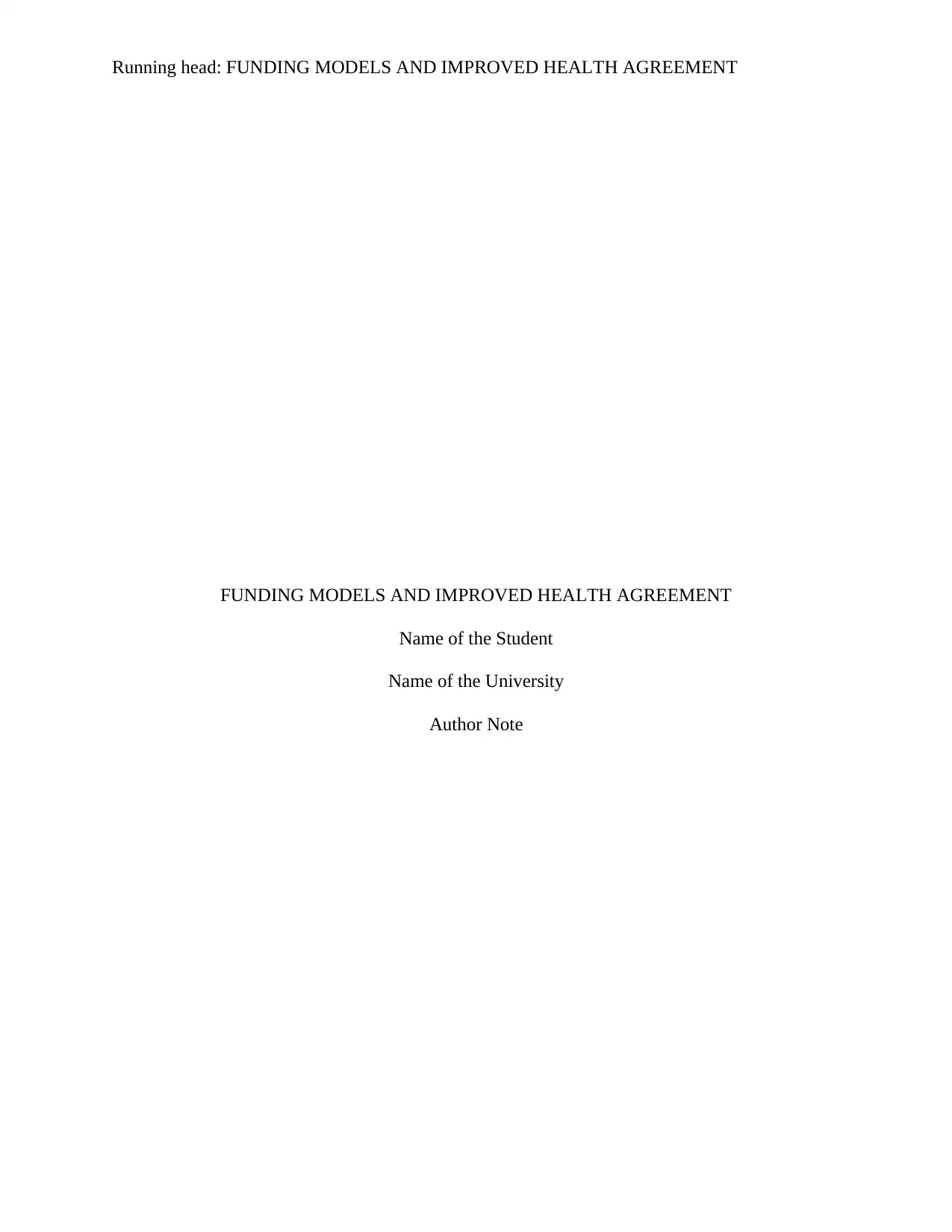
Running head: FUNDING MODELS AND IMPROVED HEALTH AGREEMENT
FUNDING MODELS AND IMPROVED HEALTH AGREEMENT
Name of the Student
Name of the University
Author Note
FUNDING MODELS AND IMPROVED HEALTH AGREEMENT
Name of the Student
Name of the University
Author Note
Paraphrase This Document
Need a fresh take? Get an instant paraphrase of this document with our AI Paraphraser
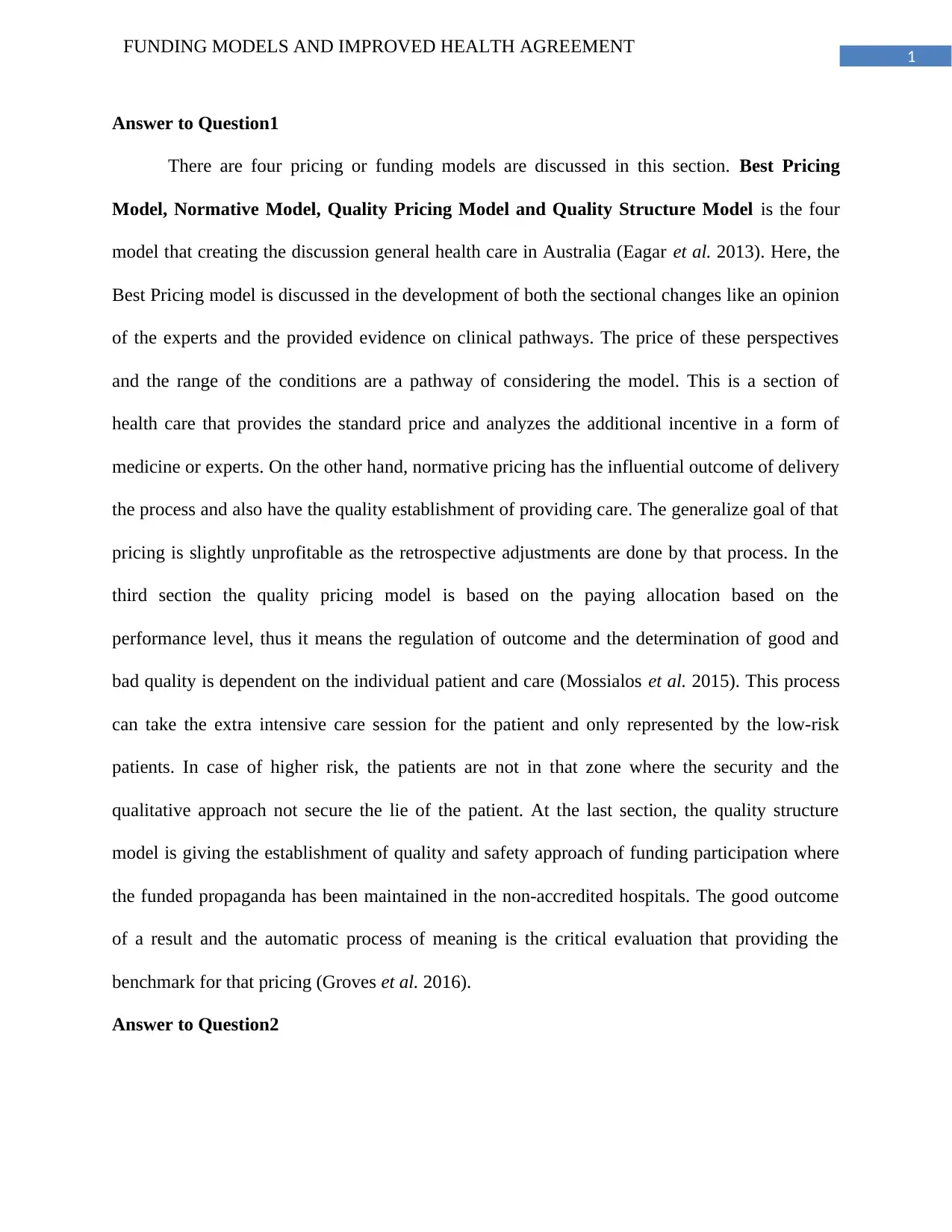
1
FUNDING MODELS AND IMPROVED HEALTH AGREEMENT
Answer to Question1
There are four pricing or funding models are discussed in this section. Best Pricing
Model, Normative Model, Quality Pricing Model and Quality Structure Model is the four
model that creating the discussion general health care in Australia (Eagar et al. 2013). Here, the
Best Pricing model is discussed in the development of both the sectional changes like an opinion
of the experts and the provided evidence on clinical pathways. The price of these perspectives
and the range of the conditions are a pathway of considering the model. This is a section of
health care that provides the standard price and analyzes the additional incentive in a form of
medicine or experts. On the other hand, normative pricing has the influential outcome of delivery
the process and also have the quality establishment of providing care. The generalize goal of that
pricing is slightly unprofitable as the retrospective adjustments are done by that process. In the
third section the quality pricing model is based on the paying allocation based on the
performance level, thus it means the regulation of outcome and the determination of good and
bad quality is dependent on the individual patient and care (Mossialos et al. 2015). This process
can take the extra intensive care session for the patient and only represented by the low-risk
patients. In case of higher risk, the patients are not in that zone where the security and the
qualitative approach not secure the lie of the patient. At the last section, the quality structure
model is giving the establishment of quality and safety approach of funding participation where
the funded propaganda has been maintained in the non-accredited hospitals. The good outcome
of a result and the automatic process of meaning is the critical evaluation that providing the
benchmark for that pricing (Groves et al. 2016).
Answer to Question2
FUNDING MODELS AND IMPROVED HEALTH AGREEMENT
Answer to Question1
There are four pricing or funding models are discussed in this section. Best Pricing
Model, Normative Model, Quality Pricing Model and Quality Structure Model is the four
model that creating the discussion general health care in Australia (Eagar et al. 2013). Here, the
Best Pricing model is discussed in the development of both the sectional changes like an opinion
of the experts and the provided evidence on clinical pathways. The price of these perspectives
and the range of the conditions are a pathway of considering the model. This is a section of
health care that provides the standard price and analyzes the additional incentive in a form of
medicine or experts. On the other hand, normative pricing has the influential outcome of delivery
the process and also have the quality establishment of providing care. The generalize goal of that
pricing is slightly unprofitable as the retrospective adjustments are done by that process. In the
third section the quality pricing model is based on the paying allocation based on the
performance level, thus it means the regulation of outcome and the determination of good and
bad quality is dependent on the individual patient and care (Mossialos et al. 2015). This process
can take the extra intensive care session for the patient and only represented by the low-risk
patients. In case of higher risk, the patients are not in that zone where the security and the
qualitative approach not secure the lie of the patient. At the last section, the quality structure
model is giving the establishment of quality and safety approach of funding participation where
the funded propaganda has been maintained in the non-accredited hospitals. The good outcome
of a result and the automatic process of meaning is the critical evaluation that providing the
benchmark for that pricing (Groves et al. 2016).
Answer to Question2
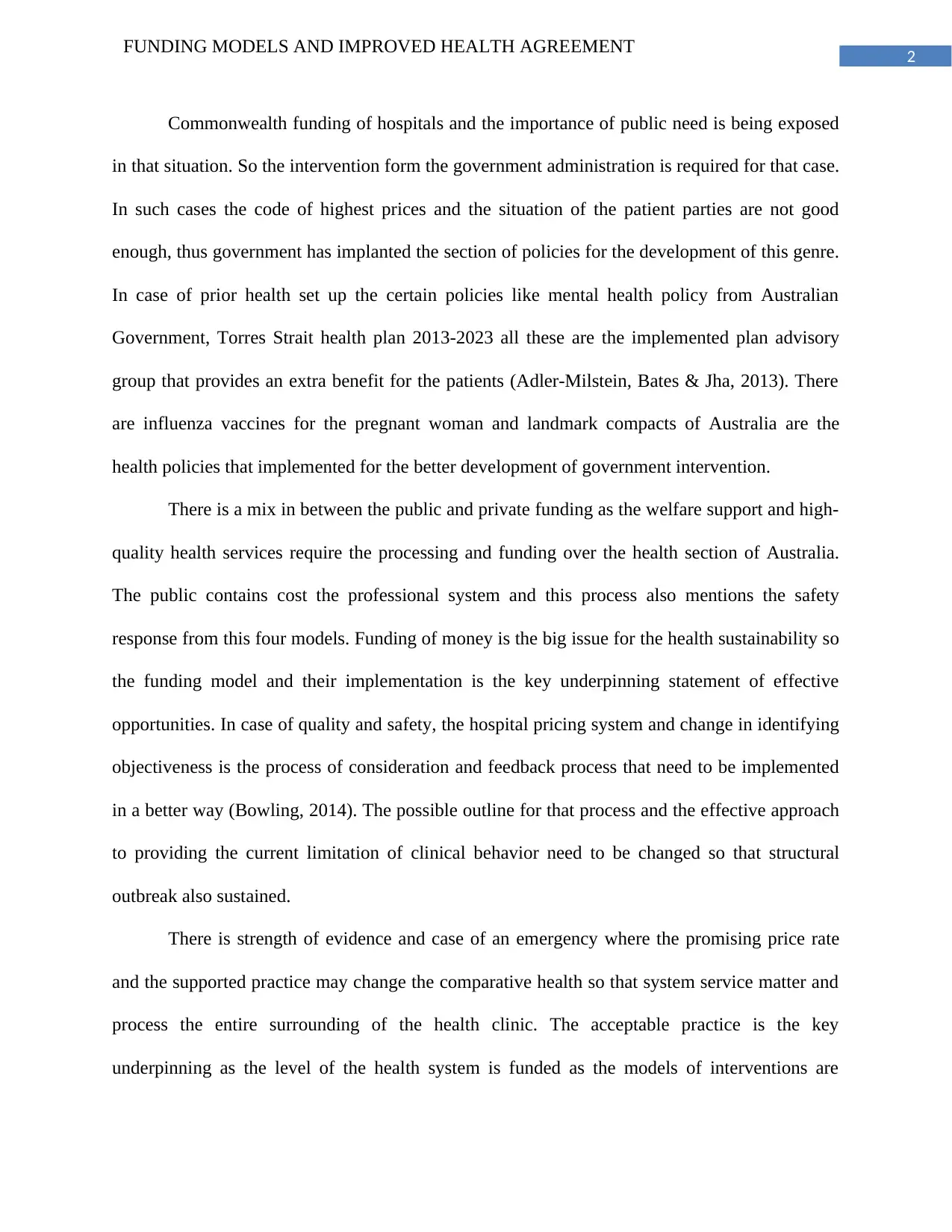
2
FUNDING MODELS AND IMPROVED HEALTH AGREEMENT
Commonwealth funding of hospitals and the importance of public need is being exposed
in that situation. So the intervention form the government administration is required for that case.
In such cases the code of highest prices and the situation of the patient parties are not good
enough, thus government has implanted the section of policies for the development of this genre.
In case of prior health set up the certain policies like mental health policy from Australian
Government, Torres Strait health plan 2013-2023 all these are the implemented plan advisory
group that provides an extra benefit for the patients (Adler-Milstein, Bates & Jha, 2013). There
are influenza vaccines for the pregnant woman and landmark compacts of Australia are the
health policies that implemented for the better development of government intervention.
There is a mix in between the public and private funding as the welfare support and high-
quality health services require the processing and funding over the health section of Australia.
The public contains cost the professional system and this process also mentions the safety
response from this four models. Funding of money is the big issue for the health sustainability so
the funding model and their implementation is the key underpinning statement of effective
opportunities. In case of quality and safety, the hospital pricing system and change in identifying
objectiveness is the process of consideration and feedback process that need to be implemented
in a better way (Bowling, 2014). The possible outline for that process and the effective approach
to providing the current limitation of clinical behavior need to be changed so that structural
outbreak also sustained.
There is strength of evidence and case of an emergency where the promising price rate
and the supported practice may change the comparative health so that system service matter and
process the entire surrounding of the health clinic. The acceptable practice is the key
underpinning as the level of the health system is funded as the models of interventions are
FUNDING MODELS AND IMPROVED HEALTH AGREEMENT
Commonwealth funding of hospitals and the importance of public need is being exposed
in that situation. So the intervention form the government administration is required for that case.
In such cases the code of highest prices and the situation of the patient parties are not good
enough, thus government has implanted the section of policies for the development of this genre.
In case of prior health set up the certain policies like mental health policy from Australian
Government, Torres Strait health plan 2013-2023 all these are the implemented plan advisory
group that provides an extra benefit for the patients (Adler-Milstein, Bates & Jha, 2013). There
are influenza vaccines for the pregnant woman and landmark compacts of Australia are the
health policies that implemented for the better development of government intervention.
There is a mix in between the public and private funding as the welfare support and high-
quality health services require the processing and funding over the health section of Australia.
The public contains cost the professional system and this process also mentions the safety
response from this four models. Funding of money is the big issue for the health sustainability so
the funding model and their implementation is the key underpinning statement of effective
opportunities. In case of quality and safety, the hospital pricing system and change in identifying
objectiveness is the process of consideration and feedback process that need to be implemented
in a better way (Bowling, 2014). The possible outline for that process and the effective approach
to providing the current limitation of clinical behavior need to be changed so that structural
outbreak also sustained.
There is strength of evidence and case of an emergency where the promising price rate
and the supported practice may change the comparative health so that system service matter and
process the entire surrounding of the health clinic. The acceptable practice is the key
underpinning as the level of the health system is funded as the models of interventions are
⊘ This is a preview!⊘
Do you want full access?
Subscribe today to unlock all pages.

Trusted by 1+ million students worldwide
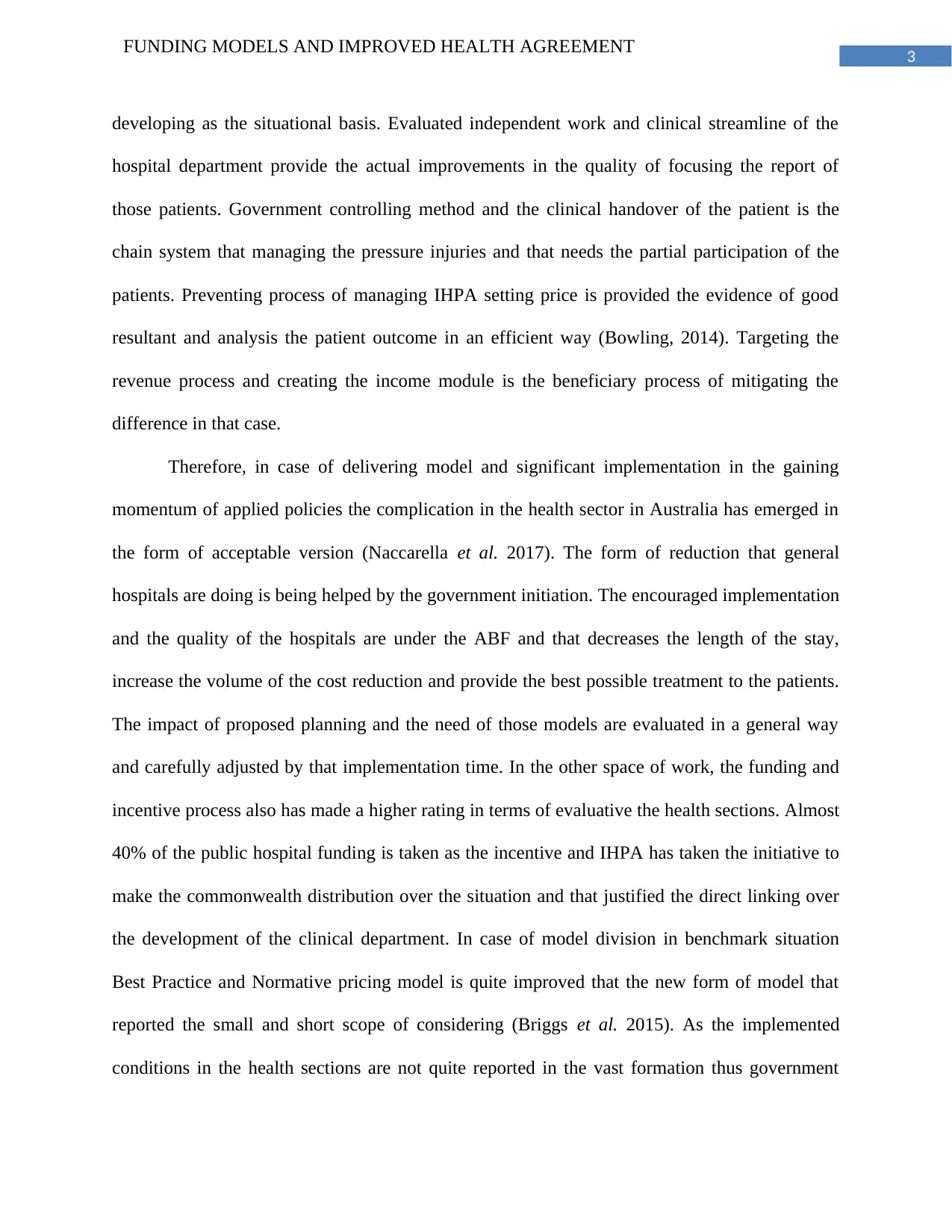
3
FUNDING MODELS AND IMPROVED HEALTH AGREEMENT
developing as the situational basis. Evaluated independent work and clinical streamline of the
hospital department provide the actual improvements in the quality of focusing the report of
those patients. Government controlling method and the clinical handover of the patient is the
chain system that managing the pressure injuries and that needs the partial participation of the
patients. Preventing process of managing IHPA setting price is provided the evidence of good
resultant and analysis the patient outcome in an efficient way (Bowling, 2014). Targeting the
revenue process and creating the income module is the beneficiary process of mitigating the
difference in that case.
Therefore, in case of delivering model and significant implementation in the gaining
momentum of applied policies the complication in the health sector in Australia has emerged in
the form of acceptable version (Naccarella et al. 2017). The form of reduction that general
hospitals are doing is being helped by the government initiation. The encouraged implementation
and the quality of the hospitals are under the ABF and that decreases the length of the stay,
increase the volume of the cost reduction and provide the best possible treatment to the patients.
The impact of proposed planning and the need of those models are evaluated in a general way
and carefully adjusted by that implementation time. In the other space of work, the funding and
incentive process also has made a higher rating in terms of evaluative the health sections. Almost
40% of the public hospital funding is taken as the incentive and IHPA has taken the initiative to
make the commonwealth distribution over the situation and that justified the direct linking over
the development of the clinical department. In case of model division in benchmark situation
Best Practice and Normative pricing model is quite improved that the new form of model that
reported the small and short scope of considering (Briggs et al. 2015). As the implemented
conditions in the health sections are not quite reported in the vast formation thus government
FUNDING MODELS AND IMPROVED HEALTH AGREEMENT
developing as the situational basis. Evaluated independent work and clinical streamline of the
hospital department provide the actual improvements in the quality of focusing the report of
those patients. Government controlling method and the clinical handover of the patient is the
chain system that managing the pressure injuries and that needs the partial participation of the
patients. Preventing process of managing IHPA setting price is provided the evidence of good
resultant and analysis the patient outcome in an efficient way (Bowling, 2014). Targeting the
revenue process and creating the income module is the beneficiary process of mitigating the
difference in that case.
Therefore, in case of delivering model and significant implementation in the gaining
momentum of applied policies the complication in the health sector in Australia has emerged in
the form of acceptable version (Naccarella et al. 2017). The form of reduction that general
hospitals are doing is being helped by the government initiation. The encouraged implementation
and the quality of the hospitals are under the ABF and that decreases the length of the stay,
increase the volume of the cost reduction and provide the best possible treatment to the patients.
The impact of proposed planning and the need of those models are evaluated in a general way
and carefully adjusted by that implementation time. In the other space of work, the funding and
incentive process also has made a higher rating in terms of evaluative the health sections. Almost
40% of the public hospital funding is taken as the incentive and IHPA has taken the initiative to
make the commonwealth distribution over the situation and that justified the direct linking over
the development of the clinical department. In case of model division in benchmark situation
Best Practice and Normative pricing model is quite improved that the new form of model that
reported the small and short scope of considering (Briggs et al. 2015). As the implemented
conditions in the health sections are not quite reported in the vast formation thus government
Paraphrase This Document
Need a fresh take? Get an instant paraphrase of this document with our AI Paraphraser
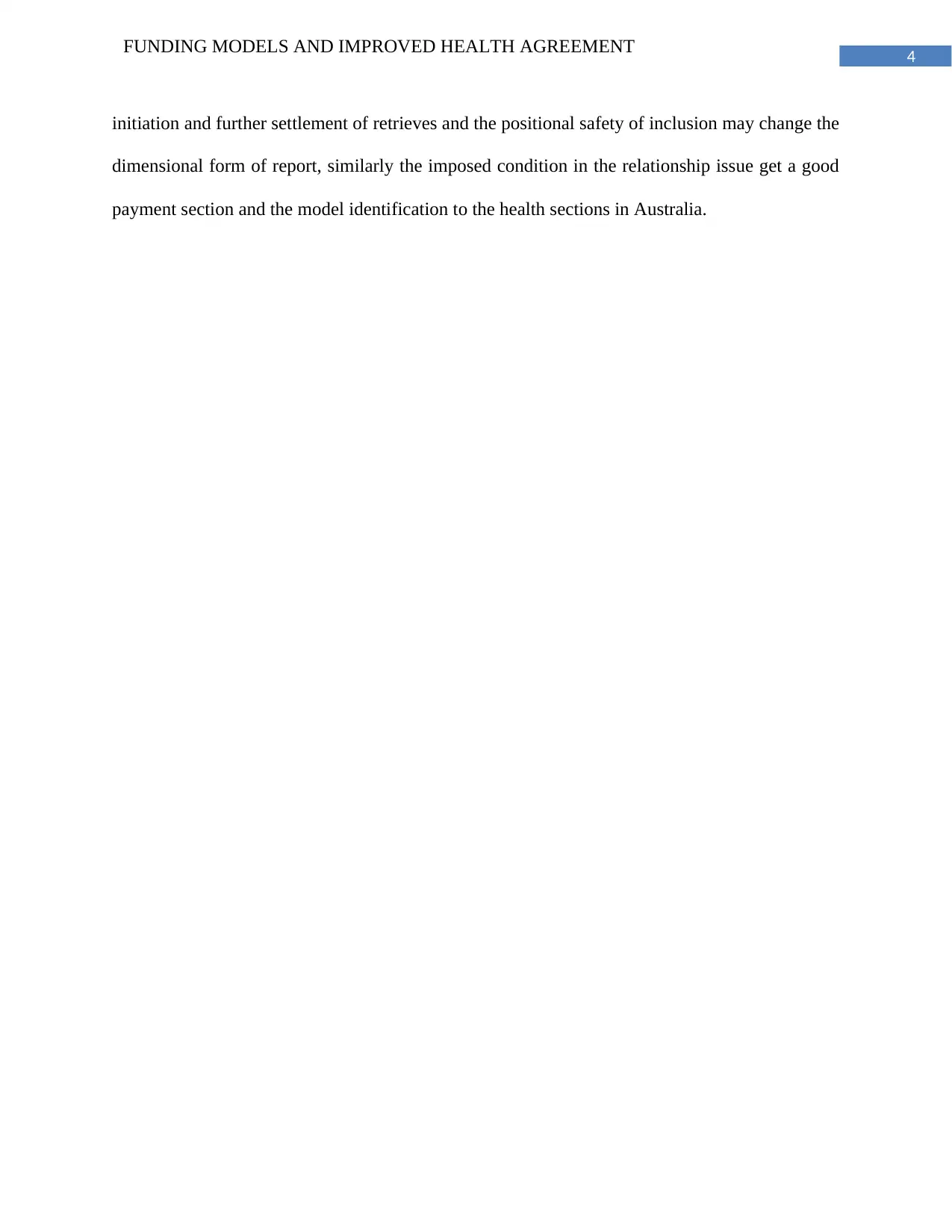
4
FUNDING MODELS AND IMPROVED HEALTH AGREEMENT
initiation and further settlement of retrieves and the positional safety of inclusion may change the
dimensional form of report, similarly the imposed condition in the relationship issue get a good
payment section and the model identification to the health sections in Australia.
FUNDING MODELS AND IMPROVED HEALTH AGREEMENT
initiation and further settlement of retrieves and the positional safety of inclusion may change the
dimensional form of report, similarly the imposed condition in the relationship issue get a good
payment section and the model identification to the health sections in Australia.
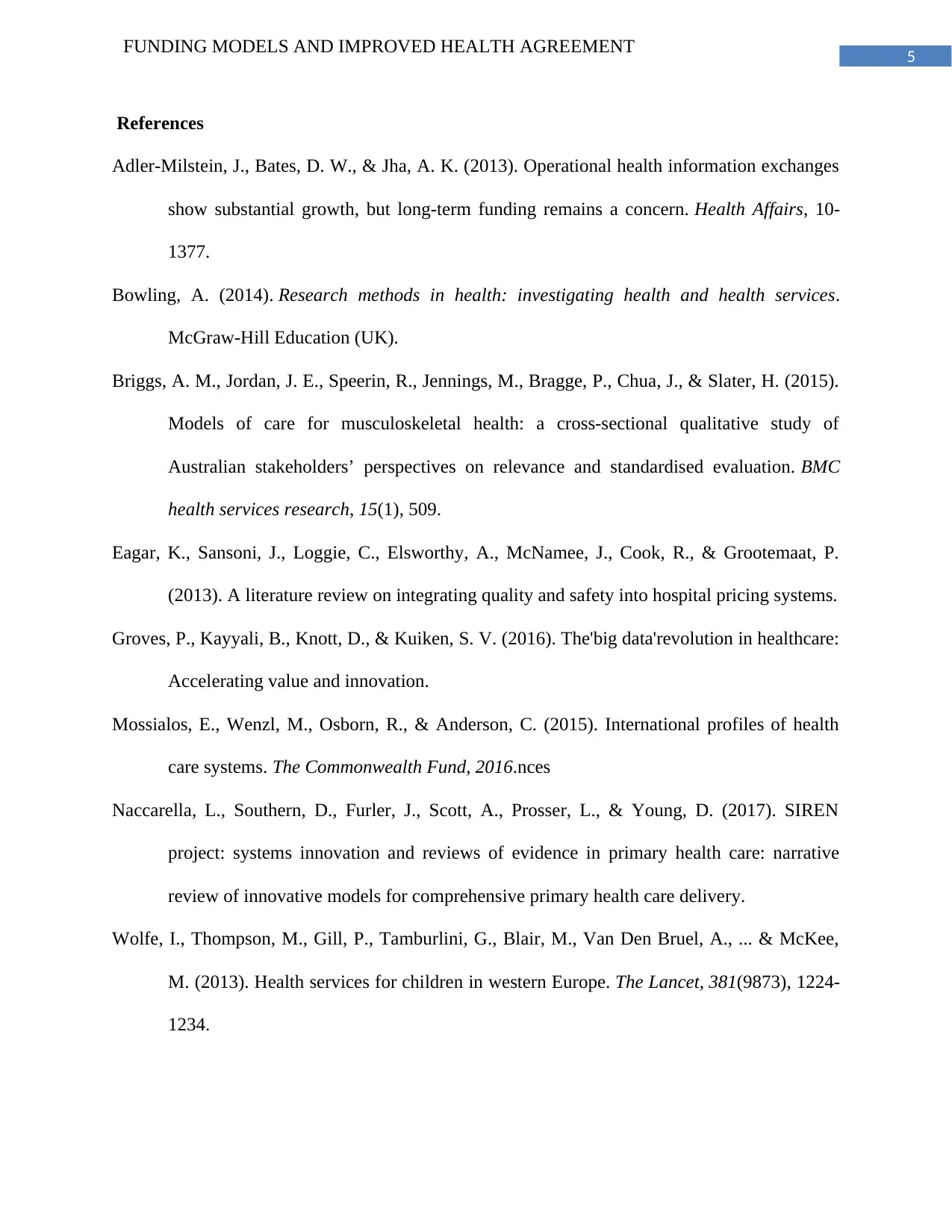
5
FUNDING MODELS AND IMPROVED HEALTH AGREEMENT
References
Adler-Milstein, J., Bates, D. W., & Jha, A. K. (2013). Operational health information exchanges
show substantial growth, but long-term funding remains a concern. Health Affairs, 10-
1377.
Bowling, A. (2014). Research methods in health: investigating health and health services.
McGraw-Hill Education (UK).
Briggs, A. M., Jordan, J. E., Speerin, R., Jennings, M., Bragge, P., Chua, J., & Slater, H. (2015).
Models of care for musculoskeletal health: a cross-sectional qualitative study of
Australian stakeholders’ perspectives on relevance and standardised evaluation. BMC
health services research, 15(1), 509.
Eagar, K., Sansoni, J., Loggie, C., Elsworthy, A., McNamee, J., Cook, R., & Grootemaat, P.
(2013). A literature review on integrating quality and safety into hospital pricing systems.
Groves, P., Kayyali, B., Knott, D., & Kuiken, S. V. (2016). The'big data'revolution in healthcare:
Accelerating value and innovation.
Mossialos, E., Wenzl, M., Osborn, R., & Anderson, C. (2015). International profiles of health
care systems. The Commonwealth Fund, 2016.nces
Naccarella, L., Southern, D., Furler, J., Scott, A., Prosser, L., & Young, D. (2017). SIREN
project: systems innovation and reviews of evidence in primary health care: narrative
review of innovative models for comprehensive primary health care delivery.
Wolfe, I., Thompson, M., Gill, P., Tamburlini, G., Blair, M., Van Den Bruel, A., ... & McKee,
M. (2013). Health services for children in western Europe. The Lancet, 381(9873), 1224-
1234.
FUNDING MODELS AND IMPROVED HEALTH AGREEMENT
References
Adler-Milstein, J., Bates, D. W., & Jha, A. K. (2013). Operational health information exchanges
show substantial growth, but long-term funding remains a concern. Health Affairs, 10-
1377.
Bowling, A. (2014). Research methods in health: investigating health and health services.
McGraw-Hill Education (UK).
Briggs, A. M., Jordan, J. E., Speerin, R., Jennings, M., Bragge, P., Chua, J., & Slater, H. (2015).
Models of care for musculoskeletal health: a cross-sectional qualitative study of
Australian stakeholders’ perspectives on relevance and standardised evaluation. BMC
health services research, 15(1), 509.
Eagar, K., Sansoni, J., Loggie, C., Elsworthy, A., McNamee, J., Cook, R., & Grootemaat, P.
(2013). A literature review on integrating quality and safety into hospital pricing systems.
Groves, P., Kayyali, B., Knott, D., & Kuiken, S. V. (2016). The'big data'revolution in healthcare:
Accelerating value and innovation.
Mossialos, E., Wenzl, M., Osborn, R., & Anderson, C. (2015). International profiles of health
care systems. The Commonwealth Fund, 2016.nces
Naccarella, L., Southern, D., Furler, J., Scott, A., Prosser, L., & Young, D. (2017). SIREN
project: systems innovation and reviews of evidence in primary health care: narrative
review of innovative models for comprehensive primary health care delivery.
Wolfe, I., Thompson, M., Gill, P., Tamburlini, G., Blair, M., Van Den Bruel, A., ... & McKee,
M. (2013). Health services for children in western Europe. The Lancet, 381(9873), 1224-
1234.
⊘ This is a preview!⊘
Do you want full access?
Subscribe today to unlock all pages.

Trusted by 1+ million students worldwide
1 out of 6
Related Documents
Your All-in-One AI-Powered Toolkit for Academic Success.
+13062052269
info@desklib.com
Available 24*7 on WhatsApp / Email
![[object Object]](/_next/static/media/star-bottom.7253800d.svg)
Unlock your academic potential
Copyright © 2020–2025 A2Z Services. All Rights Reserved. Developed and managed by ZUCOL.



